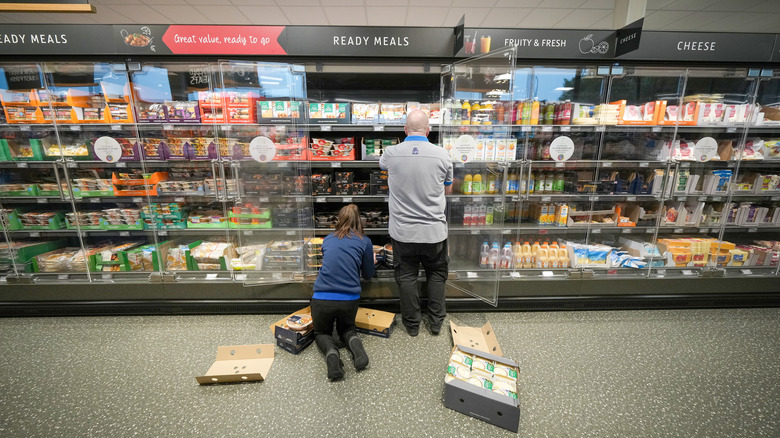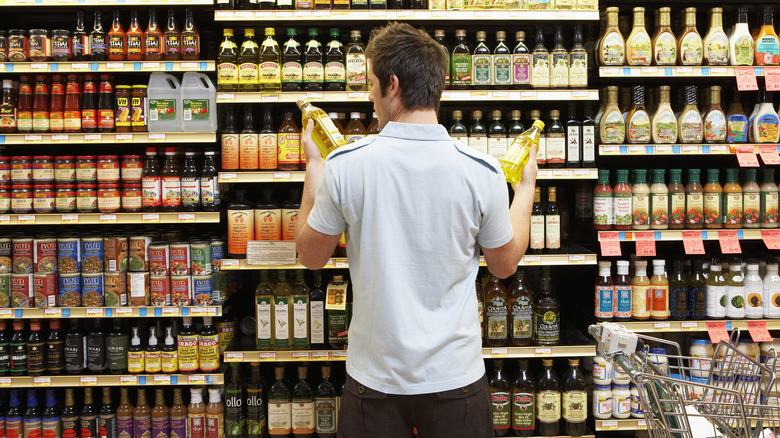The Tempting Psychology Behind One-Way Grocery Store Doors
It's hard to imagine life before grocery stores as they're known today, but supermarkets as an essential shopping concept are on the whole a relatively recent development. Take Piggly Wiggly, which opened its doors in Memphis in 1916, as a case study. Before Piggly Wiggly — which many consider the first major chain grocer of its time — shoppers would usually consult with a general store clerk upon entering the establishment; this person would subsequently gather items and accept payment at the end. Conversely, Piggly Wiggly allowed customers to shop for their own goods, an incredibly novel experience at the time.
Supermarket patrons are now wholly accustomed to this self-service shopping approach, which many originally found enticing: It meant products were available at a lower cost in comparison to traditional general stores. Over time, savvy supermarket owners began utilizing specific layouts for marketing purposes with the goal of persuading shoppers to buy more items than they actually need or want. This is today evident in the location-related configuration of different departments and supermarket sections today, as well as the logic behind store product placements. But it doesn't stop there — even the front door of a grocery store is specially designed to increase how much you spend.
Grocery store layouts are designed to take your money
There's a very good reason why a planned, brief excursion to their local supermarket can turn into a full-blown errand, and it begins with something as simple as a door. The next time you're shopping, consider the entrance of the establishment. If the grocery store is like many others, you'll notice that the front door is one-way only. As National Geographic explains it, one-way doors force shoppers to navigate the rest of the store to locate the exit, and it's often not a direct route from A to B. The logic behind this is that as a result, you'll encounter goods and products that are simply too attractive to resist, even if you have a reliable shopping list in tow.
Similarly, most grocery stores utilize a very specific layout with the purpose of taking shoppers on a sensory experience. This usually entails placing certain departments — including the floral shop, produce department, and bakery, among others — as close to the entrance as possible. Flowers imbue the area with a pleasing aroma, which puts shoppers in a good mood. Next is the produce section, which offers an array of vibrant colors, interesting textures, and equally pleasing scents. The bakery comes after, and its fresh-baked bread and delicious pastries are sure to get some hunger pangs going. While this layout is tailor-made for financial gain, shoppers can defend against its charms with the right approach.
How to avoid temptation during supermarket trips
When shoppers are aware of the common placement of items within grocery stores, they can make better decisions to avoid temptation. Imagine that you're hitting a local store after work with the goal of picking up a gallon of milk. Keep in mind that grocery staples, such as milk, meat, and eggs, are almost always located at the back of the building to ensure you walk by as many goods as possible. In that sense, heading straight for these departments can stop impulse purchases and keep your shopping budget in check.
You should also know how individual shelves are arranged to ensure you're privy to the most affordable items when shopping. Because they're just about eye level to most shoppers, the second and third shelves tend to have the most expensive items. If you're in search of a bargain, look at the shelf directly below them for items that are equal in quality but usually lower in price. Displays at the end of aisles, also known as endcaps, serve a similar purpose in that they feature attractive items that are usually priced higher than other goods. Avoid these areas unless they contain a specific item you need. With just a little planning and foresight, you can make it through your next grocery trip without going overboard.


